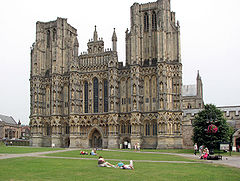Diocese of Bath and Wells
| Diocese of Bath and Wells Church of England | |
| Province: | Canterbury |
|---|---|
| counties: | Somerset |
| Wells Cathedral west front | |
| Bishop: | Peter Price |
| Cathedral: | Wells Cathedral |
| Organisation | |
| Suffragan bishop(s): |
Bishop of Taunton |
| Archdeaconries: | Bath, Wells, Taunton |
| No. of parishes: | 477 |
| No. of churches: | 569 |
| Details | |
| Website: | Bath and Wells |
The Diocese of Bath and Wells is a Church of England diocese within the Province of Canterbury. The diocese covers Somerset, excluding the areas in the north of the county which form part of the Diocese of Bristol.
The bishop of the diocese is the Bishop of Bath and Wells, and his seat Wells Cathedral ("the Cathedral Church of Saint Andrew" in the city of Wells.
Contents
History
Foundation
Before 909, Somerset lay within the Diocese of Sherborne, but in that year Athelm (later Archbishop of Canterbury) was appointed the first bishop of the Diocese of Wells, making the secular church there into the diocesan cathedral. The secular canons at Wells vied with the monks of the monasteries at Glastonbury and Bath for supremacy in the diocese and it was with difficulty that the cathedral retained its status, so much so that the canons were reduced to begging in order to obtain their bread. It was to this impoverished cathedral church that the Bishop Gisa was appointed in 1060. Under him, grants of land were obtained successively from the kings Edward the Confessor, Harold and William the Conqueror and buildings were constructed for the secular community.
Gisa's successor, John de Villula (1088-1122), moved the see to become the Diocese of Bath in 1090, using the Abbey Church of Ss Peter and Paul as his cathedral and in so doing he regressed the position of the cathedral at Wells. Robert of Lewes, appointed bishop in 1136, enhanced the position of Wells. As well as rebuilding the cathedral he instituted the arrangement by which although Bath retained precedence, the seat was located in both churches and the bishop was elected by both chapters. However the diocesan title remained the same.
Bishop Reginald fitz Jocelin (1174-91) brought Saint Hugh of Lincoln to England and his successor, Savaric FitzGeldewin (1192-1205) forcibly annexed Glastonbury Abbey to the diocese in 1197. He moved his seat there and the see was renamed the Diocese of Glastonbury. The monks of Glastonbury, however, rejected Savaric's authority and the title Diocese of Bath and Glastonbury was therefore used for all practical purposes until his successor, Jocelin of Wells, a native of Wells itself, renounced the claim to Glastonbury in 1219. Thereupon he adopted the style Diocese of Bath. Although he did not use the name of Wells in his title, his contribution to the city was greater than any other bishop of the diocese: under his authority the cathedral was restored and enlarged, adding the west front, making this the visual signature of the building. Further, he increased the thirty-five canons to fifty and founded a grammar school for the city.
After Jocelin's death in 1242, the monks at Bath unilaterally elected one of their number, Roger, as successor, in disregard for the chapter of Wells. His appointment received confirmation from King Henry III, so the chapter at Wells appealed the decision to Rome, with the result that the Pope declared, on 3 January 1245, that whilst Roger should remain, he would be bishop of a see thenceforth styled the Diocese of Bath and Wells, the name by which the diocese has been known ever since.
Mediæval diocese of Bath and Wells
William of Bitton bishop from 1267-74 was renowned for his piety, and his tomb became a place of pilgrimage in Wells. The completion of the buildings was achieved under Bishop Ralph of Shrewsbury (1329-63). Thomas Beckington (1443-65) was another noted liberal benefactor of the city.
Oliver King (1495-1503) rebuilt Bath Abbey in the late Perpendicular style. The work was begun in 1499 and completed in 1530 under Bishop John Clerk. The abbey was the last complete monastic edifice to be completed before the impending Reformation. He was succeeded by Adrian de Castello (1504-18) who was an absentee bishop, under whom the see was administered by Polydore Vergil the noted historian. Adrian's successor Cardinal Wolsey (1518-23) was also an absentee bishop, held the see concurrently with that of York.
From the Reformation
The abbey at Bath was dissolved by King Henry VIII in 1538 during the Reformation. Thereafter the Church of England bishop, though retaining the old style, had his seat at Wells alone. William Barlow, was appointed in 1548. He fled in 1553 on the accession of Queen Mary I, and his successor was the Roman Catholic Gilbert Bourne (1554-59). Bourne was deprived and imprisoned in the Tower of London by Queen Elizabeth I, and died there in 1569.
Today the diocesan offices, the bishops' offices and residences and the cathedral are all located in Wells, but the title "Bath and Wells" remains unchanged.[1]
Diocesan structure
The Diocese is split into three archdeaconries: Bath, Taunton and Wells. These in turn are split into 18 deaneries:
|
|
|
Outside links
References
Sources
- L. S. Colchester. (1982). Wells Cathedral: A History. Open Books
- The Catholic Encyclopedia
- Church of England Statistics 2002
| Dioceses of the Church of England |
|---|
|
Province of Canterbury: |

